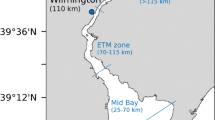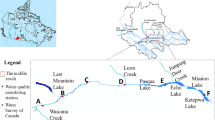Abstract
There were two phytoplankton blooms captured by remote sensing in Lake Michigan in 1998, one from March to May, and one during June. In this paper, those phytoplankton blooms were simulated by a coupled physical–biological model, driven by observed meteorological forcing in 1998. The model reasonably reproduced the lake currents. The biological model results, with and without riverine nutrient loading, were compared with the remote sensing data. A 3-month-long donut-like phytoplankton bloom that appeared in southern Lake Michigan was reasonably well simulated only when riverine input was included, indicating the importance of riverine nutrient input for supporting the growth of phytoplankton in Lake Michigan. The model with riverine input also captured a second event-driven phytoplankton bloom during June with weaker magnitude that occurred in mid-south Lake Michigan, which lasted for about 20 days. The major reason for the weaker bloom in June was that vertical mixing in the hydrodynamic model was too weak (leading to a mixed-layer depth of 20 m) to bring the bottom nutrient-rich water up to the epilimnion. High chlorophyll concentration that persisted in Green Bay for almost a year was simulated with less intensity.











Similar content being viewed by others
References
Bai X, Wang J, Schwab DJ, Yang Y, Luo L, Leshkevich GA, Liu S (2013) Modeling 1993–2008 climatology of seasonal general circulation and thermal structure in the Great Lakes using FVCOM. Ocean Model 65:40–63
Beletsky D, Saylor JH, Schwab DJ (1999) Mean circulation in the Great Lakes. J Great Lakes Res 25(1):78–93. https://doi.org/10.1016/S0380-1330(99)70718-5
Beletsky D, Schwab DJ (2001) Modeling circulation and thermal structure in Lake Michigan: annual cycle and interannual variability. J Geophys Res 106(C9):19,745–19,771
Beletsky D, Schwab DJ, Roebber PJ, McCormick MJ, Miller GS, Saylor JH (2003) Modeling wind-driven circulation during the March 1998 sediment resuspension event in Lake Michigan. J Geophys Res 108(C2):3038. https://doi.org/10.1029/2001JC001159
Beletsky D, Schwab D, McCormick M (2006) Modeling the 1998–2003 summer circulation and thermal structure in Lake Michigan. J Geophys Res 111:C10010. https://doi.org/10.1029/2005JC003222
Beletsky D, Schwab D (2008) Climatological circulation in Lake Michigan. Geophys Res Lett 35:L21604. https://doi.org/10.1029/2008GL035773
Bennington V, McKinley GA, Kimura N, Wu CH (2010) General circulation of Lake Superior: mean, variability, and trends from 1979 to 2006. J Geophys Res 115:C12015. https://doi.org/10.1029/2010JC006261
Bennington V, McKinley GA, Urban NR, McDonald CP (2012) Can spatial heterogeneity explain the perceived imbalance in Lake Superior's carbon budget? A model study. J Geophys Res 117:G03020. https://doi.org/10.1029/2011JG001895
Chapra SC, Sonzogni WC (1979) Great Lakes total phosphorus budget for the mid 1970s. J Water Pollut Control Fed:2524–2533
Chen C, Ji R, Schwab DJ, Beletsky D, Fahnenstiel GL, Jiang M, Johengen TH, Vanderploeg H, Eadie B, Budd JW, Bundy MH, Gardner W, Cotner J, Lavrentyev PJ (2002) A model study of the coupled biological and physical dynamics in Lake Michigan. Ecol Model 152:145–168
Chen C, Wang L, Ji R, Budd JW, Schwab DJ (2004) Impacts of suspended sediment on the ecosystem in Lake Michigan: a comparison between the 1998 and 1999 plume events. J Geophys Res 109:C10S05. https://doi.org/10.1029/2002JC001687
Chen C, Beardsley RC, Cowles G (2006) An unstructured-grid, finite-volume Coastal Ocean Model (FVCOM) system. Oceanography 19(1):78–89. https://doi.org/10.5670/oceanog.2006.92
Hu H, Wang J (2010) Modeling effects of tidal and wave mixing on circulation and thermohaline structures in the Bering Sea: process studies. J Geophys Res 115:C01006. https://doi.org/10.1029/2008JC005175
Ji R, Chen C, Budd JW, Schwab DJ, Beletsky D, Fahnenstiel GL, Johengen TH, Vanderploeg HA, Eadie BJ, Cotner J, Gardner W, Bundy M (2002) Influences of suspended sediments on the ecosystem in Lake Michigan: a 3-D coupled bio-physical modeling experiment. Ecol Model 152:169–190
Kerfoot WC, Budd JW, Green SA, Cotner JB, Biddanda BA, Schwab DJ, Vanderploeg HA (2008) Doughnut in the desert: late-winter production pulse in southern Lake Michigan. Limno Oceanography 53(2):589–604
Lesht BM, Fontaine TD III, Dolan DM (1991) Great Lakes total phosphorus model: post audit and regionalized sensitivity analysis. J Great Lakes Res 17(1):3–17
Lesht BM, Stroud JR, McCormick MJ, Fahnenstiel GL, Stein ML, Welty LJ, Leshkevich GA (2002) An event-driven phytoplankton bloom in southern Lake Michigan observed by satellite. Geophys Res Lett 29(8):1177. https://doi.org/10.1029/2001GL013533
Li, R., C. Chen, H. Xia, R. C. Beardsley, M. Shi, Z. Lai, H. Lin, Y. Feng, C. Liu, Q. Xu, Y. Ding, Y. Zhang (2014). Observed wintertime tidal and subtidal currents over the continental shelf in the northern South China Sea. J Geophys Res, 22. Doi:10.1002/2014JC009931
Luo L, Wang J, Schwab DJ, Vanderploeg H, Leshkevich G, Bai X, Hu H, Wang D (2012) Simulating the 1998 spring bloom in Lake Michigan using a coupled physical-biological model. J Geophys Res 117:C10011. https://doi.org/10.1029/2012JC008216
Nalepa, T.F., D.L. Fanslow, G.A. Lang, K. Mabrey, and M. Rowe, 2014. Lake-wide benthic surveys in lake michigan in 1994-95, 2000, 2005, and 2010: abundances of the amphipod diporeia spp. and abundances and biomass of the mussels dreissena polymorpha and dreissena rostriformis bugensis. NOAA Technical Memorandum GLERL-164, 25pp
Mouw CB, Chen H, McKinley GA, Effler S, O’Donnell D, Perkins MG, Strait C (2013) Evaluation and optimization of bio-optical inversion algorithms for remote sensing of Lake Superior’s optical properties. J Geophys Res Oceans 118:1696–1714. https://doi.org/10.1002/jgrc.20139
Oveisy A., R.R. Yerubandi, L.F. Leon, and S.A. Bocaniov (2014). 3-D winter modeling and effects of ice cover on hydrodynamics. Thermal structure and water quality in Lake Erie. J Great Lakes Research (in press)
Powers CF, Ayers JC (1960) Water transport studies in the straits of Mackinac region of Lake Huron. Limnol Oceanogr 5:81–85
Pilcher DJ, McKinley GA, Bootsma HA, Bennington V (2015) Physical and biogeochemical mechanisms of internal carbon cycling in Lake Michigan. J Geophys Res Oceans 120:2112–2128. https://doi.org/10.1002/2014JC010594
Rowe, M., E. Anderson, J. Wang, and H. Vanderploeg, 2015. Modeling the effect of invasive quagga mussels on the spring phytoplankton bloom in Lake Michigan. J Great Lakes Res. 41:17 pp. https://doi.org/10.1016/j.jglr.2014.12.018113
Saylor JH, Sloss PW (1976) Water volume transport and oscillatory current flow through the Straits of Mackinac. J Phys Oceanogr 6:229–237. https://doi.org/10.1175/1520-0485(1976)006<0229:WVTAOC>2.0.CO;2
Shuchman RA, Leshkevich G, Sayers MJ, Johengen TH, Brooks CN, Pozdnyakov D (2013) An algorithm to retrieve chlorophyll, dissolved organic carbon, and suspended minerals from Great Lakes satellite data. J. Great Lakes Res. Suppl 39:14–33
Tian R, Chen C, Qi J, Ji R, Beardsley RC, Davis C (2014) Model study of nutrient and phytoplankton dynamics in the Gulf of Maine: patterns and drivers for seasonal and interannual variability. ICES J Mar Sci. https://doi.org/10.1093/icesjms/fsu090
Vanderploeg HA et al (2007) Anatomy of the recurrent coastal sediment plume in Lake Michigan and its impacts on light climate, nutrients, and plankton. J Geophys Res 112:C03S90. https://doi.org/10.1029/2004JC002379
Van Cleave K, Lenters JD, Wang J, Verhamme EM (2014) A regime shift in Lake Superior ice cover, evaporation, and water temperature following the warm El Niño winter of 1997-98. Limnol Oceanogr 59(6):1889–1898. https://doi.org/10.4319/lo.2014.59.6.1889
Wang D-R, Yang Y, Wang J, Bai X (2015) A modeling study of the effects of river runoff, tides, and surface wind-wave mixing on the eastern and western Hainan upwelling systems of the South China Sea. China Ocean Dyn. https://doi.org/10.1007/s10236-015-0857-3
Wang J (1996) Global linear stability of the two-dimensional shallow water equations: application of the distributive theorem of roots for polynomials on the unit circle. Mon Wea Rev 124(6):1301–1310. https://doi.org/10.1175/1520-0493(1996)124<1301:GLSOTT>2.0.CO;2
Wang J, Hu H, Schwab D, Leshkevich G, Beletsky D, Hawley N, Clites A (2010) Development of the Great Lakes Ice-circulation model (GLIM): application to Lake Erie in 2003-2004. J Great Lakes Res 36:425–436. https://doi.org/10.1016/j.jglr.2010.04.002
White B, Austin J, Matsumoto K (2012) A three dimensional model of Lake Superior with ice and biogeochemistry. J Great Lakes Res 30(1):61–71
Acknowledgements
We appreciate the support from EPA Great Lakes Restoration Initiative to the climate change project awarded to Drs. B. Lofgren and J. Wang. Thanks also go to Nicole Rice for editing the draft. This is GLERL Contribution No. 1865. Luo appreciates support by the National Natural Science Foundation of Guangdong, China (2014A030313777) and from the Overseas Partnership Innovative Project of SCSIO.
Author information
Authors and Affiliations
Corresponding author
Additional information
Responsible Editor: Tal Ezer
This article is part of the Topical Collection on the 8th International Workshop on Modeling the Ocean (IWMO), Bologna, Italy, 7–10 June 2016
Appendix A: The mathematical expressions for each term of Eqs. (1)–(4) are given as
Appendix A: The mathematical expressions for each term of Eqs. (1)–(4) are given as
where the definition of each parameter in the equations (a1–a10) is given in Appendix B.
1.1 Appendix B
Table 3
Rights and permissions
About this article
Cite this article
Luo, L., Wang, J., Hunter, T. et al. Modeling spring-summer phytoplankton bloom in Lake Michigan with and without riverine nutrient loading. Ocean Dynamics 67, 1481–1494 (2017). https://doi.org/10.1007/s10236-017-1092-x
Received:
Accepted:
Published:
Issue Date:
DOI: https://doi.org/10.1007/s10236-017-1092-x




